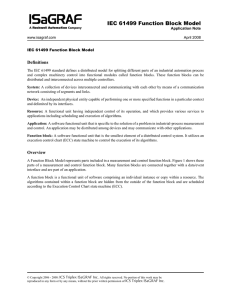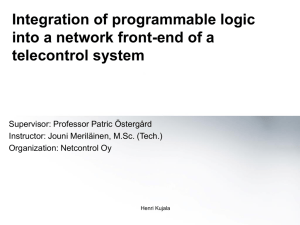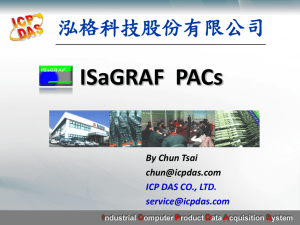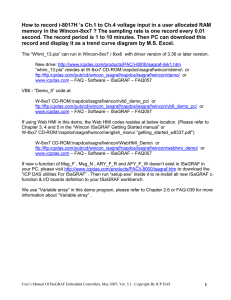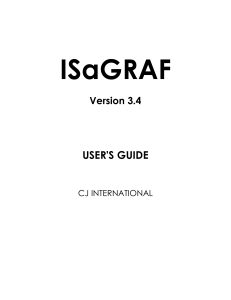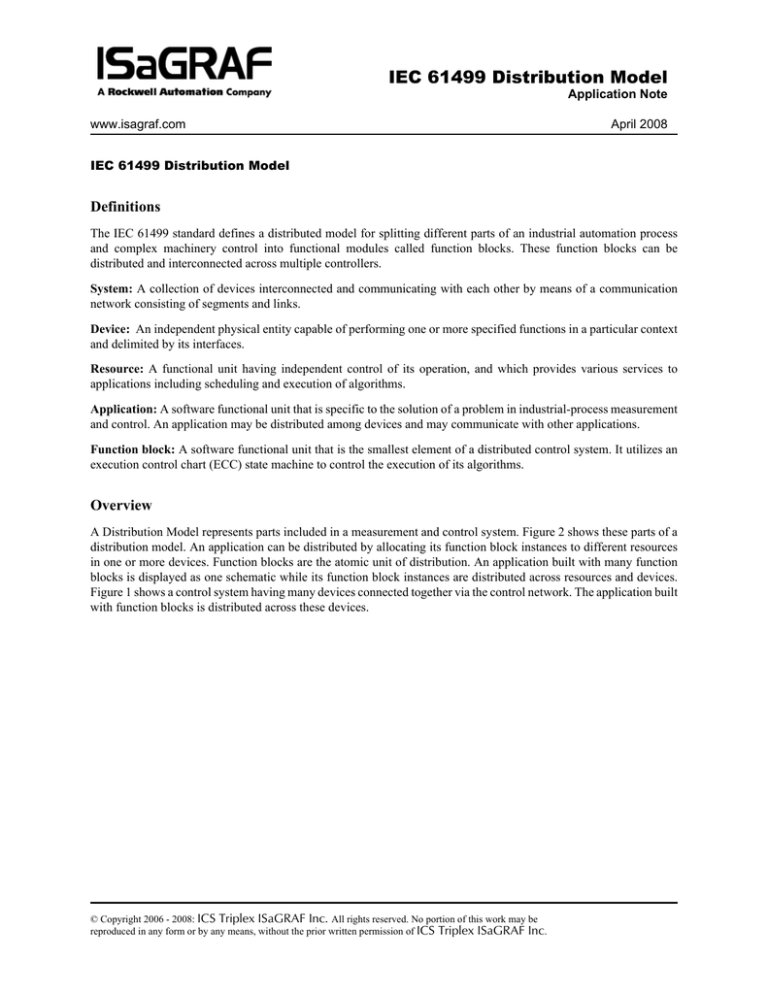
IEC 61499 Distribution Model
Application Note
www.isagraf.com
April 2008
IEC 61499 Distribution Model
IEC 61499 Distribution Model
Definitions
The IEC 61499 standard defines a distributed model for splitting different parts of an industrial automation process
and complex machinery control into functional modules called function blocks. These function blocks can be
distributed and interconnected across multiple controllers.
System: A collection of devices interconnected and communicating with each other by means of a communication
network consisting of segments and links.
Device: An independent physical entity capable of performing one or more specified functions in a particular context
and delimited by its interfaces.
Resource: A functional unit having independent control of its operation, and which provides various services to
applications including scheduling and execution of algorithms.
Application: A software functional unit that is specific to the solution of a problem in industrial-process measurement
and control. An application may be distributed among devices and may communicate with other applications.
Function block: A software functional unit that is the smallest element of a distributed control system. It utilizes an
execution control chart (ECC) state machine to control the execution of its algorithms.
Overview
A Distribution Model represents parts included in a measurement and control system. Figure 2 shows these parts of a
distribution model. An application can be distributed by allocating its function block instances to different resources
in one or more devices. Function blocks are the atomic unit of distribution. An application built with many function
blocks is displayed as one schematic while its function block instances are distributed across resources and devices.
Figure 1 shows a control system having many devices connected together via the control network. The application built
with function blocks is distributed across these devices.
© Copyright 2006 - 2008: ICS Triplex ISaGRAF Inc. All rights reserved. No portion of this work may be
reproduced in any form or by any means, without the prior written permission of ICS Triplex ISaGRAF Inc.
IEC 61499 Distribution Model
Figure 1: Distributed Application
Many devices (Configuration) are connected together via a communication network. The device is a self-contained
hardware capable of executing a control loop. The device is a controller having a processor, memory devices and may
contain a communication network when used in a distributed application. The devices are PLCs solving the control
logic and can be seen in intelligent actuators such as valves or in sensors such as flow meters. Any field bus can serve
as communication network. Industrial Ethernet, Profibus, DeviceNet are among those often used. Some networks are
faster while others are more deterministic. The choice of network depends on the process to control. Hard real-time or
soft real-time applications need specialized communication networks to meet the time-critical behaviors.
An automation and process control application runs in a single device or across mutiple devices to split the load and
use the feature specialty of each device.
© Copyright 2006 - 2008: ICS Triplex ISaGRAF Inc. All rights reserved. No portion of this work may be
reproduced in any form or by any means, without the prior written permission of ICS Triplex ISaGRAF Inc.
2
IEC 61499 Distribution Model
Figure 2: IEC 61499 Distribution Model
An application may consist of one or more control loops where input sampling is performed in one device, control
processing is performed in a second device, and output conversion is performed in a third device. These cooperative
control loops share data in a predictive and deterministic way described in the IEC 61499 standard.
In ISaGRAF, each program can be a distributed application. Figure 3 shows distributed applications across devices.
This is the Distribution Model displayed by the ISaGRAF toolset. All function block bitmaps (yellow) at the right of
the application name indicate the distribution across devices. A bitmap displayed below a device means that the
program has a part running in that device. The absence of a bitmap below a device means that the program has no part
running in that device. For each program built using the ISaGRAF toolset, the System Model viewer quickly displays
the distribution of the application. Each device can have either a bitmap representation or the standard icon.
The communication network connects together devices that are part of a distributed system. Many communication
networks are displayed if such is configured in the system. Some devices may use one communication network while
others may use another.
A distributed application exchanges data across the communication network. The ISaGRAF elements use the
communication network transparently. Building and compiling the application generates all required link parameters.
Each distributed element of an application is connected to the others across the communication network. Upon
building an ISaGRAF application, the distributed application generator automatically links these distributed elements
together.
Figure 3 shows the devices, the communication network, the applications, the distributed relationship between devices
and applications as well as the application schematic. Application_A has parts running on the first, second, and third
device. Application_B has parts running on the last two devices of the system. Application_C runs only on the first
device. Each part of Application_A exchanges the proper information across the communication network. The same
applies to Application_B.
In the System Model view, double-clicking an application displays its schematic view. The schematic view is the
Application Model. In this view, there are no device boundaries. It is a one schematic for the distributed application.
Each function block in the application can be assigned to a resource which is also assigned to a device. The event and
© Copyright 2006 - 2008: ICS Triplex ISaGRAF Inc. All rights reserved. No portion of this work may be
reproduced in any form or by any means, without the prior written permission of ICS Triplex ISaGRAF Inc.
3
IEC 61499 Distribution Model
data signals between the function blocks are simple to draw. The ISaGRAF distribution generator creates all required
links between these signals. These links exchange information transparently on the communication interface.
The functional relationships between the function blocks of an application are unaffected by its distribution. The
ISaGRAF toolset takes care of the whole distributed aspect of the application. Delays are added in the communication
interface and in the algorithms execution that must be taken into account when designing such a distributed application.
Figure 3: The ISaGRAF Distribution Model Viewers
References
International Electrotechnical Commission: Function Blocks Part 1 - Architecture (61499-1 © CEI:200X).
ICS Triplex ISaGRAF Inc.: ISaGRAF User’s Guide. November 2005.
© Copyright 2006 - 2008: ICS Triplex ISaGRAF Inc. All rights reserved. No portion of this work may be
reproduced in any form or by any means, without the prior written permission of ICS Triplex ISaGRAF Inc.
4

